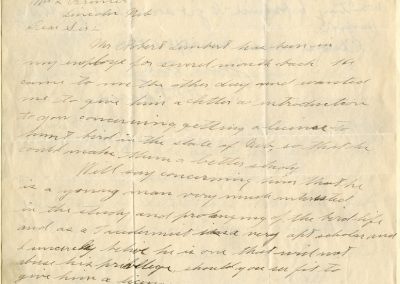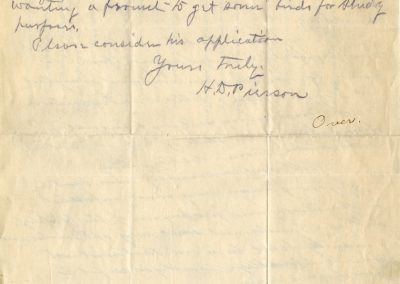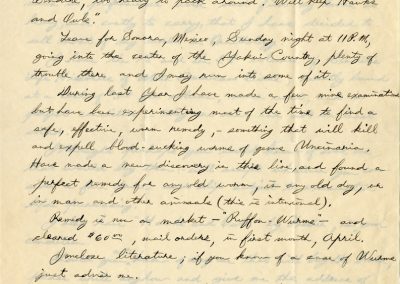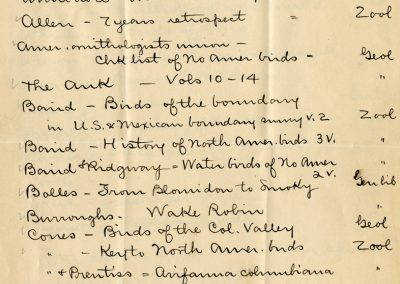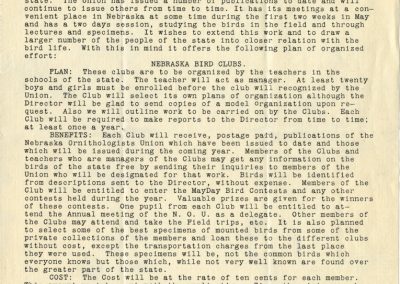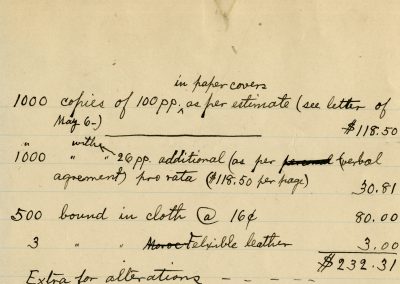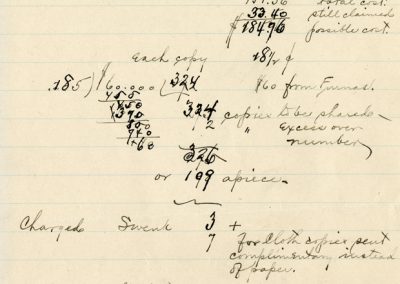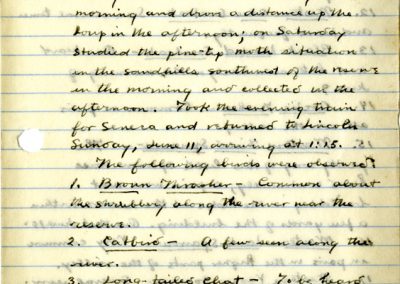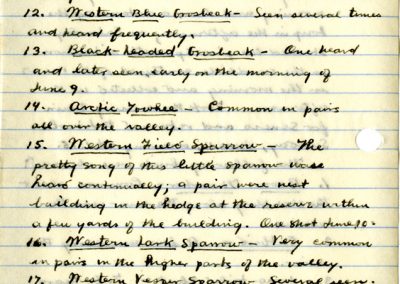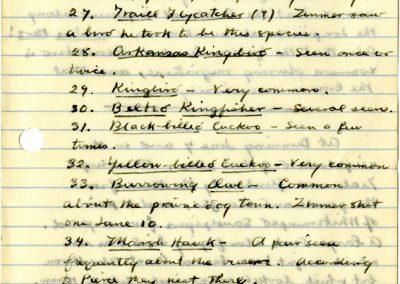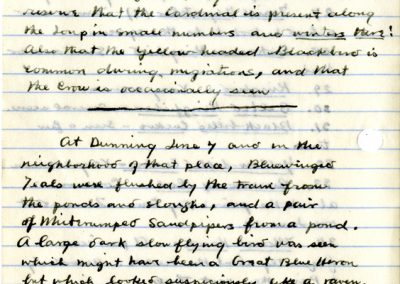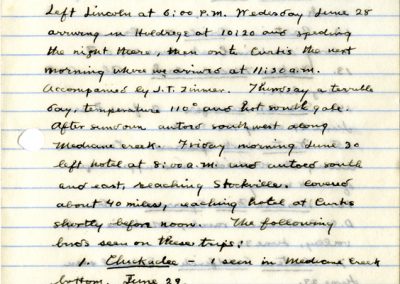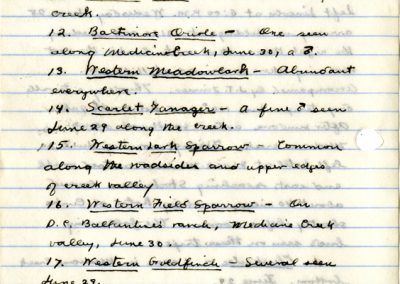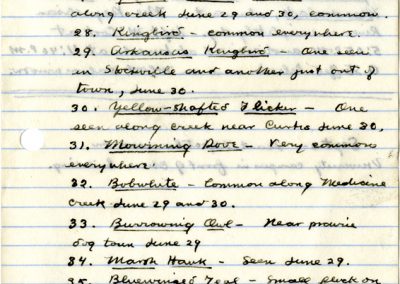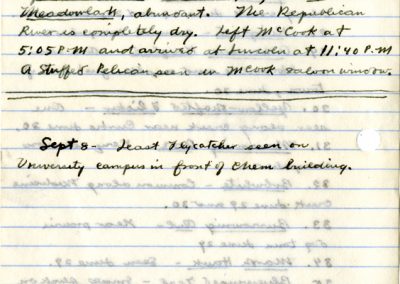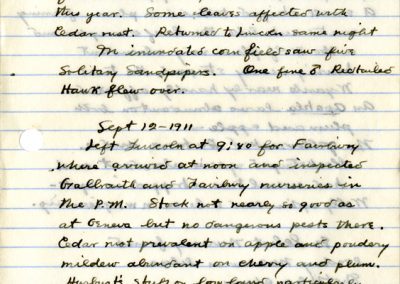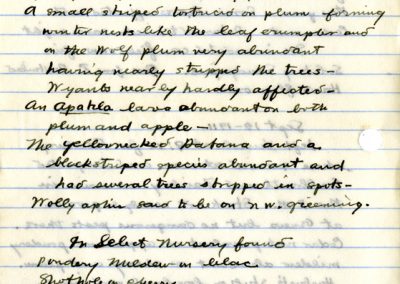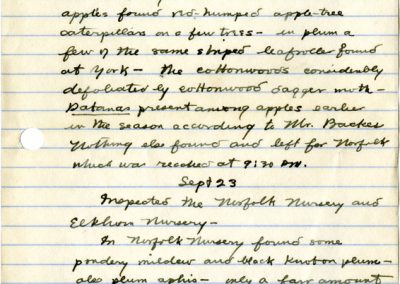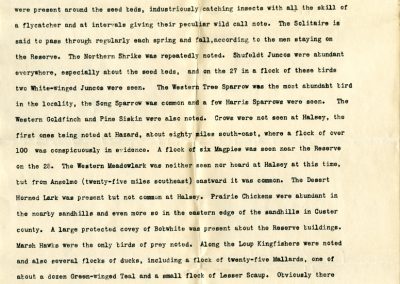Great Nebraska
Naturalists and ScientistsNebraska Ornithologists’ Union
Letters, Undated
D.D. Wallace, Letter
J. E. Wallace. Taxidermist and Fur Dresser. 605 South 13th Street.
Omaha, Neb. 190
Mr. L. Bruner Lincoln, Neb Dear Sir:- Mr. Robert Limbert has been in my employe for several months back. He came to me the other day and wanted me to give him a letter of introduction to you concerning getting a license to hunt bird in the state of Neb. so that he could make them a better study.
Will say concerning him that he is a young man very much interested in the study and prolonging of the bird life and as a Taxidermist is a very apt scholar and I sincerely belive he is one that will not abuse his privilege should you see fit to give him a license. Very truly yours D. D. Wallace
Over.
H.D. Pierson, Letter
Mr. Geo. L. Carter Chief Game Warden Lincoln, Nebr.
Dear Sir:-The [illegible] is Mr. R. W. Limbert the gentleman that works for Mr. Wallace and this gentleman that I spoke to you about wanting a permit to get some birds for study purposes. Please considers his application. Yours truly H. D. Pierson
Over.
Rupert E. Preston, Letter
MAY 1 Ans’d
Lawrence Bruner, Lincoln, Nebr.
Dear Sir and Friend:- Received your letter. Sold my two volumes of Bendire, too heavy to pack around. Will keep “Hawks and Owls.”
Leave for Sonora, Mexico, Sunday night at 11 P.M., going into the center of the Yakui Country, plenty of trouble there and I may run into some of it.
During last year I have made a few mine examinations but have been experimenting most of the time to find a safe, effective, worm remedy, – something that will kill and expell blood-sucking worms of genus Uncinaria. Have made a new discovery in this line, and found a perfect remedy for any old worm, in any old dog, ok in man and other animals (this is [illegible]).
Remedy is now on market – “Ruffon-Wurms” – and cleared $60.00, mail order, in first month, April.
I enclose literature; if you know of a case of Wurms just advise me. Yours Very Sincerely, Rupert. E. Preston. 3035 Vine St., K. C. – Mo.
Library Letter
In reply to yours of
The University of Nebraska Library
Lincoln TN 99
My dear Prof Bruner: Here follows a list of Bird books available on the campus.
Allen – 7 years retrospect = Zool Amer. ornithologist union- chklist of No Amer birds = Geol The Auk – Vols 10 – 14 = ” Baird – Birds of the boundary in U.S. + Mexican boundary survey v.2 Zool Baird – History of North Amer. birds 3v. ” Baird + Ridgway = Waterbirds of No Amer 2v. ” Bolles – From Blomidon to Smoky Gen lib Burroughs – Wake Robin ” Cones – Birds of the Col. Valley Geol ” – Key to North Amer. birds Zool ” + Prentiss = Avifauna columbiana ” Dekay – Birds of New York ” Evans – ” Ent Oberholser – Birds of Wayne Co Ohio Zool Parker – Secondary … rays in wings of Carinate birds “
Wilson Tout, Letter
Educational Committee: Wilson Tout, Supt. City Schools, North Platte, Chairman. Lawrence Bruner, University of Nebraska, Lincoln. H.B. Duncanson, State Normal, Peru. Miss Anna Caldwell, State Normal, Kearney. Miss Caroline Stringer, High School, Omaha.
The Nebraska Ornithologist’s Union. Devoted to the Study of the Birds of Nebraska.
–
To the Teachers of Nebraska: The Nebraska Ornithologists Union is an organization of men and women of Nebraska which has for its object the study of the birds of the state. The Union has issued a number of publications to date and will continue to issue others from time to time. It has its meetings at a convenient place in Nebraska at some time during the first two weeks in May and has a two days session, studying the birds in the field and through lectures and specimens. It wishes to extend this work and to draw a larger number of the people of the state into closer relation with the bird life. With this in mind it offers the following plan of organized effort:
NEBRASKA BIRD CLUBS. PLAN: These clubs are to be organized by the teachers in the schools of the state. The teacher will act as manager. At least twenty boys and girls must be enrolled before the club will recognized by the Union. The Club will select its own plans of organization although the Director will be glad to send copies of a model organization upon request. Also we will outline work to be carried on by the Clubs. Each Club will be required to make reports to the Director from time to time; at least once a year.
BENEFITS: Each Club will receive, postage paid, publications of the Nebraska Ornithologists Union which have been issued to date and those which will be issued during the coming year. Members of the Clubs and teachers who are managers of the Clubs may get any information on the birds of the state free by sending their inquiries to members of the Union who will be designated for that work. Birds will be identified from descriptions sent to the Director, without expense. Members of the Club will be entitled to enter the MayDay Bird Contests and any other contests held during the year. Valuable prizes are given for the winners of these contests. One pupil from each Club will be entitled to attend the Annual meeting of the N. O. U. as a delegate. Other members of the Clubs may attend and take the Field trips, etc. It is also planned to select some of the best specimens of mounted birds from some of the private collections of the members and loan these to the different clubs without cost, except the transportation charges from the last place they were used. These specimens will be, not the common birds which everyone knows but those which, while not very well known are found over the greater part of the state.
COST: The Cost will be at the rate of ten cents for each member. This amount must be sent with the application. Since the minimum number of members is twenty, the cost of organizing the club will be not less than two dollars.
Think over the benefits of this plan. There are many things which have not yet been worked out. You may see difficulties. Just write them to the Director and ask him any further questions. Dont delay the matter. Membership can be taken for only one year at a time and the present year will end with Febr. 1., 1911. You have been recommended to us as being interested in this work. We have you on our lists. If you cannot organize a club this year please write and tell us so and let us know just why, if it is any fault with the plan. Write any way. Address the Director, Wilson Tout, North Platte, Nebr.
Lawrence Bruner, Note, 1904
1000 copies of 100 pp. in paper covers as per estimate (see letter of May 6) $118.50
1000 copies with 26 pp. additional (as per verbal agreement) pro rata ($118.50 per page) 30.81
500 bound in cloth @ 16 cents 80.00
3 bound in Felxible leather $3.00 _______
$232.31
Extra for alterations – – – – –
Lawrence Bruner, Note, 1904 (2)
cost paper copies $118.50 100 – 100 pp. 26% 30.81 149.31 drayage & frt. 2.05 151.36 total cost.
33.40 still claimed
$184.76 possible cost.
Each copy 28 1/2 cents 185 ) 160.000 324 455 1450 1370 800 740 60
$ 160 from Furnas 324 copies to be shared 2 copies Excess over number
326 or 109 apiece.
~
Charged Swenk 3 + 7 for cloth copies sent complimentary instead of paper.
Wolcott 11
Leaving Swenk 99 Bruner 109 Wolcott 98 66 copies N.O.U. shared 22 22 22 Set aside for N.O.U 20 20 20 58 67 56
Swenk has in additional lg share set aside (20) not used, claim on copies represented by 1/3 amount of disputed claim – ($33.40)
Myron Swenk, Field Notes
– 1911 –
July 10-12-1909 Oct 27-29 – 1910 June 7-10-1911
Trip to Halsey, Thomas County.
Left Lincoln at 11:a.m. Wednesday June 7, 1911, and arrived at Halsey at 8:20 the same evening. Next morning collected in the sandhills south of the reserve buildings and in the afternoon made studies of the pine-tip moth; on Friday collected in the river valley in the morning and drove a distance up the Loup in the afternoon; on Saturday studied the pine-tip moth situation in the sandhills southwest of the reserve in the morning and collected in the afternoon. Took the evening train for Seneca and returned to Lincoln Sunday, June 11, morning at 1:15.
The following birds were observed: 1. Brown Thrasher – Common about the shrubbery along the river near the reserve. 2. Catbird – A few seen along the river. 3. Long-tailed Chat – To be heard about the reserve buildings any time of day or night. Mr. Zimmer found a nest with four eggs June 9. 4. Maryland Yellowthroat – Common in the shrubbery along the river. 5. Black & White Warbler – Mr. Zimmer found this bird at one place in the shrubbery along the Loup. 6. Bell Vireo – Seen once or twice in the thin timber and brush near the river
Zimmer found a nest with 5 eggs June 9. 23. Thick-billed Redwing – Redwings, presumably this form, were very common along the river and the sloughs along the railroad track. 24. Cowbird – Common. 25. Blue Jay – Several seen and heard 26. Desert Horned Lark – Common in the hills, paired, and probably nesting. 27. Trail Flycatcher (?) – Zimmer saw a bird he took to be this species. 28. Arkansas Kingbird – seen once or twice. 29. Kingbird – Very common 30. Belted Kingfisher – Several seen. 31. Black-billed cuckoo – Seen a few times. 32. Yellow-billed cuckoo – Very common. 33. Burrowing Dove – Common about the prairie dog town. Zimmer shot one June 10. 34. Marsh Hawk – A pair seen frequently about the reserve. According to Pierce they nest there. 35. Mourning Dove – Abundant. 36. Prairie Hen – Common in the hills. 37. Bobwhite – Very common about the reserve. 38. Killdeer – Several pairs about the reserve, some obviously nesting near by. 39. Sennet Nighthawk – Abundant all along the valley at dusk. 40. Great Blue Heron – Several individuals seen.
–
In addition to these birds actually seen I am informed by the men at the reserve that the Cardinal is present along the Loup in small numbers and winters there! Also that the yellow headed Blackbird is common during migrations, and that the Crow is occasionally seen
–
At Dunning June 7 and in the neighborhood of that pace, Bluewinged Teals were flushed by the train from the ponds and sloughs, and a pair of Whiterumped Sandpipers from a pond. A large dark slow flying bird was seen which might have been a Great Blue Heron but which looked suspiciously like a raven. V plano Plover were seen several times.
–
In the course of conversation Mr. John Hollars who is working on the reserve and who lives near Alliance says that Ravens are not uncommon in the winter about Alliance and that early in May he shot one from a group of four. He was famliar with the Raven in Army service in Arizona. He mentioned particularly the
white bars of the feathers on the neck so that there is no doubt but that the bird shot was the Whitenecked Raven (Corvis cryptoleucus)!
–
Trip to Curtis, Fronteier County.
Left Lincoln at 6:00 p.m. Wednesday June 28 arriving in Holdrege at 10:20 and speding the night there., then on to Curtis the next morning where we arrived at 11:30 a.m. Accompanied by J. T. Zimmer. Thursday, a terrible day, temperature 110 degrees and hot south gale. After sundown autoed southwest along Medicine Creek. Friday morning June 30 left hotel at 8:00 a.m. and autoed south and east, reaching Stockville. Covered about 40 miles, reaching hotel at Curtis shortly before noon. The following birds seen on these trips: 1. Chickadee – 1 seen in Medicine Creek bottom, June 29. 2. Western Mockinbird – Several seen between Curtis and Stockville, June 30. 3. White-rumped Skrike – 7 woar twice seen along road, same as above. 4. Barn Swallow.- One seen on fence along Medicine Creek, June 29. ?5. Long-tailed Chat – Thought to have been heard from Lake View hotel early on morning of June 30. 6. Brewer Blackbird. Zimmer saw 3 or 4,
–
Trip to McCook, Red Willow Co.
Left Lincoln on #1 at 7:15 and arrived at McCook at 1:10 P.M. in order to attend grasshopper meeting there. Meeting over at
–
Sept. 8 – Least Flycatcher seen on University campus in front of Chem building.
Sept. 11 – 1911 – Left Lincoln at 7:15 and arrived at Geneva at 9:00 am. Drove at once with Mr. Brown to the nurseries. Examined first a smaller field, then the propagating field and finally the apple field of thousands of young trees. Was particularly careful in examination of the field from which was reported Putnan Scale this year. Some leaves affected with Cedar rust. Returned to Lincoln same night. The inundated corn field saw five Solitary Sandpipers. One fine male Redtailed Hawk flew over.
Sept. 12 – 1911 Left Lincoln at 9:40 for Fairbury where arrived at noon and inspected Galbraith and Fairbury nurseries in the P.M. Stock not nearly as good as at Geneva but no dangerous pests there. Cedar rust prevalent on apple and powdery mildew abundant on cherry and plum. Harburt’s stuff on low land particularly poor, better on the hill. Left for Beatrice in the evening where arrived at 9: P.M. Barn swallows thick on the telegraph wires.
Sept. 13 – 1911 Inspected Sonderregger’s German Nursery in the morning. Stuff fair, better than at Fairbury. Roses had Black spot (Actinonema rosae). Saw a Cooper Hawk and other ordinary birds only.
Sept. 18 Examined York Nursery and found Shothole on cherry and plum Powdery Mildew on plum and apple Cedar Rust on wealthy apple Altermana fungus on poplar Aphis prunifoliae curling plum leaves A small striped torbucid on plum forming winter nests like the leaf crumpler and on the Wolf plum very abundant having nearly stripped the trees – Wyants nearby hardly affected. An Apatila larva abundant on both plum and apple – The yellownecked Datona and a blackstriped species abundant and had several trees stripped i spots. Wooly aphis said to be on nw. greening.
In Select Nursery found Powdery Mildew on lilac Shothole on cherry A caterpillar on carolina poplar.
Sept. 19 Examined Kearney Nursery. Very little stuff. Leafspot on gooseberry.
Sept 22 Examined the Albion Nursery at Albion having come up from Lincoln as far as Columbus last night. Found a little powdery mildew. Very little stock and that in good condition. Left for Humphrey at 2:00 PM and arrived at Humphrey at 5:00 P.M when I examined the Humphrey Nurseries. In the apples found red-humped apple-tree caterpillars on a few trees – in plum a few of the same striped leafroller found at York – the cottonwoods considerbly defoliated by cottonwood dagger moth – Datanas present among apples earlier in the season according to Mr. Backes Nothing else found and left for Norfolk which was reached at 9:30 PM.
Sept. 23 Inspected the Norfolk Nursery and Elkhorn Nursery. In Norfolk Nursery found some powdery mildew and black knobon plum – also plum aphis – only a fair amount of stuff and apparently clean. In Elkhorn Nursery found only a few rows of cherry and apple – no insects but a little mildew. Left at 12:50 after hours visit with Mr. Sessions. He reports the Blackheaded Grosbeak common about his home this summer, the first ever noted. Reached Lincoln at 6:15 PM.
Myron Swenk, Field Notes
LATE OCTOBER BIRDS OF THE THOMAS COUNTY SANDHILLS. – While investigating an insect enemy of the small pines on the Forest Reserve at Halsey, October 27 to 29, 1910, I made a few notes on the bird life of the locality at that season. These are interesting, not because of the rarity of any of the species observed, but because some additional data on distribution and migration are brought out. On these days the Bluebird was common and the Robin abundant at the Reserve, while several pairs of Townsend Solitaire were present around the seed beds, industriously catching insects with all the skill of a flycatcher and at intervals giving their peculiar wild call note. The Solitaire is said to pass through regularly each spring and fall, according to the men staying on the Reserve. The Northern Shrike was repeatedly noted. Shufoldt Juncos were abundant everywhere, especially about the seed beds, and on the 27 in a flock of these birds two White-winged Juncos were seen. The Western Tree Sparrow was the most abundant bird in the locality, the Song Sparrow was common and a few Harris Sparrows were seen. The Western Goldfinch and Pine Siskin were also noted. Crows were not seen at Halsey, the first ones being noted at Hazard, about eighty miles south-east, where a flock of over 100 was conspicuously in evidence. A flock of six Magpies was seen near the Reserve on the 28. The Western Meadowlark was neither seen nor heard at Halsey at this time, but from Anselmo (twenty-five miles southeast) eastward it was common. The Desert Horned Lark was present but not common at Halsey. Prairie Chickens were abundant in the nearby sandhills and even more so in the eastern edge of the sandhills in Custer county. A large protected covey of Bobwhite was present about the Reserve buildings. Marsh Hawks were the only birds of prey noted. Along the Loup Kingfishers were noted and also several flocks of ducks, including a flock of twenty-five Mallards, one of about a dozen Green-winged Teal and a small flock of Lesser Scaup. Obviously there is a general tendency for open country birds to shift toward the eastern edge of the sandhills in the late fall.
Myron H. Swenk, Lincoln
